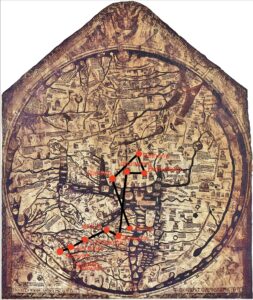The Evesham Mapamundi puts an emphasis on contemporary architecture(Barber 13-, which my map of 10 of Kempe’s destinations simply doesn’t. (Barber 22, 13,33)This is created through the many buildings, including a castle in Jerusalem, that are present.(Barber 14) It is very possible that this was simply done to make the map appear more interesting for many viewers, but could have also been potentially helpful for travelers. The islands on the Evesham Mappamundi seem to have had a lot of thought put into them, however they don’t seem to be very convincing because of how similar their rectangular shapes are.(Barber 14).The modern map is much more detailed with regards to shape. In addition, there are not any borders between places in Europe or any other of the other continents which is different from my map which has yellow lines depicting borders on the Evesham Map (Barber 14). One of the castles near Jerusalem looks as if it is completely out of proportion because it touches both sides of the small peninsula that it is on (Barber 14) These can point to many things, such as the artist not having gone to any or most of the places that he drew to needing to draw something a certain way at the request of his patron. The artist of the Evesham map was also much more concerned with using colors that popped and kept their viewers’ attention(EBay.com) whereas the map I plotted for my assignment had a more natural color scheme that included a lot of green. The Evesham map does not contain a lot of representation of land being green, which makes me believe that the author’s intention of making this map have enough religious symbolism in order to belong in a church made him in such as spiritual state that there was not a concern for making land on earth look like real land, because heaven was in his eyes the far more important world. What is also very interesting is that Jerusalem’s and Europe’s terrain is the same color, making it seem to viewers that Jerusalem and Europe are naturally similar looking places. Barbar paints the artist as religious so this would make sense(EBay, Barber 22)
The Red sea takes up a lot of space in the Evesham Mappamundi’s upper right corner, which is contrasted with the map that I plotted Kempe’s journey on, not affording it any significance. Like the drawing of Adam and Eve, this was very likely created because of the author’s expression of his devout Christainity, which I believed I discussed in my Medieval Map essay.(Barber 14, 22)The thin border of water, which I assume represents the ocean, shows how the artist for whatever reason wanted to depict the water as something that was under his own control.
As my plotted map only includes the places that Kempe traveled to(Kempe 1-176), it covers a lot less space than the Mappamundi. I also believe that the Evesham Mappamundi makes everything look so nice that it would have been a nod to God for having created the world in the way that it is depicted here. Everything seems to be drawn with so much care as to honor the artist’s maker. (Barber 14)
Works Cited
Barber, Peter. “The Evesham World Map: A Late Medieval English View of God and the World.” Imago Mundi, vol. 47, 1995, pp. 13–33, http://www.jstor.org/stable/1151300. Accessed 28 Apr. 2022.
EBay.com, LARGE HARDBACK MAP THE EVESHAM WORLD MAP 1415 A.D. CELEBRATES ENGLISH COMMERCE, Ebay.com Accessed April 28, 2022,https://www.ebay.com/itm/185377531779?hash=item2b295ca783:g:z7QAAOSwNC5dVr1c
Margery Kempe, the Book of Margery Kempe, translated by BA Windeatt, Peguin Books, 1975
Modern map sources https://docs.google.com/document/d/1ppRhwWdYvRzDDbQpikbEDUpQ2UY-g_uxF1euW8ylhnw/edit?usp=sharing
